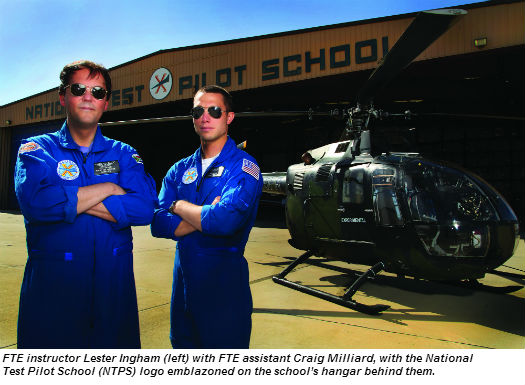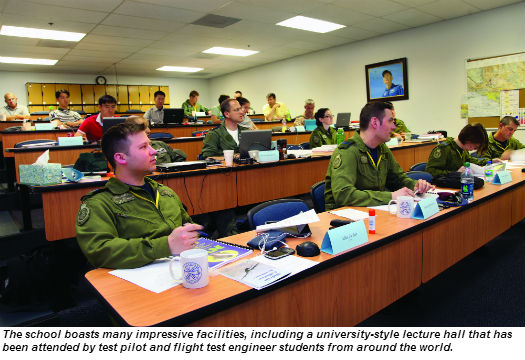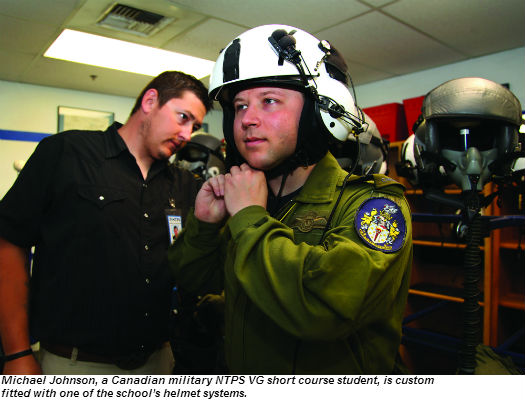
There is a certain beauty and allure to the High Desert of Southern California. And for aircraft enthusiasts, this area is special on a whole other level — these vast, windblown plains have, since the 1940s, been witness to some of aviation’s greatest developmental moments.
Nestled in this somewhat austere, sparsely populated region some 90 miles (145 kilometers) north of Los Angeles is the National Test Pilot School (NTPS) in Mojave. The NTPS has been in operation for over 30 years as a 501(c)(3) not-for-profit educational institute, governed by a board of trustees and contributing to that sometimes taken-for-granted aspect of aviation on which a large part of aircraft safety and performance is based. Established in 1981 to meet the flight-test training needs of the United States and foreign aerospace industries and governments, the NTPS has since established a highly regarded position of excellence in the training of test pilots (TPs) and flight test engineers (FTEs).
More than just being a top school in a somewhat exclusive field, though, the NTPS is unique because it is a civilian owned school in a sea of military ones. Of the seven TP schools recognized by the Society of Experimental Test Pilots, most are military, including major players like the U.S. Naval Test Pilot School in Patuxent River, Md.; the U.S. Air Force (USAF) Test Pilot School at Edwards Air Force Base (AFB), some 20 miles southeast of Mojave; École du Personnel Navigant d’Essais et de Réception in France; and the Empire Test Pilots’ School in the United Kingdom. Therein lies one of the NTPS’s major differences — and strengths. Said president and chief executive officer Allen Peterson, “The U.S. military schools predominately train their own military personnel, which is their mission, but here at the NTPS, we train customers from around the world; that’s why to refer to ourselves as ‘the world’s test pilot school.’ ”
When first visiting NTPS, the dominating picture one gets from the runway is the full-length sign that sits atop the main hangar, emblazoned with the school’s name and logo. To anyone with knowledge of and/or a love for aviation, it inspires both confidence and a sense of the area’s history. After all, it is not uncommon to hear the sonic booms of USAF jets from nearby Edwards AFB, passing the speed of sound in the very same skies where Chuck Yeager made his infamous supersonic flight in October 1947.

But, the NTPS is working to ensure new history can be made. And, that begins with its impressive facilities and equipment: from its university-style lecture hall and immaculate hangar, to the highest levels of technological testing equipment and simulators, and its diverse and superbly maintained fleet of fixed- and rotary-wing aircraft.
On the fixed-wing side, that fleet includes former military jets, numerous general aviation aircraft, a surrogate RPV (remotely piloted vehicle) Cessna 150, four Garmin G1000 glass-cockpit-equipped aircraft and a FADEC (fullauthority digital engine control) Diamond DA42. On the rotary-wing side, the fleet consists of two MBB Bo.105s, two Bell OH58s, a Hughes 500C and a Bell UH-1N.
Just as important as the facilities and equipment, of course, is what’s taught — and who’s teaching it.
The NTPS’s curriculum centers on its full, one-year “professional course” for fixed- and rotary-wing TPs and FTEs. The modules that make up the professional (long) course can be taken on their own as both full modules or smaller, academic-only short courses. And, there are a host of other non-credit, short and on-demand courses that can serve as introductory or refresher classes.
Through its graduate wing, the National Flight Test Institute, the NTPS offers two degree tracks: one leading to a master of science in flight test engineering (which is accredited by the Accreditation Board for Engineering and Technology), the other leading to a master of science in flight test and evaluation. The degree granted depends upon the student’s undergraduate qualifications, and requires completion of the professional course, plus a final project.

The faculty, meanwhile, consists of nine part-time instructors and about a dozen full-time instructors, each of whom have greatly varied backgrounds and flight test experience, including several who have foreign military backgrounds. That diversity is a huge benefit to the students, who, according to Peterson, are largely from overseas: “If you looked at an average student from the NTPS long course, you’d primarily find international military, predominantly from NATO countries.”
With a student body comprised of people from over 30 countries, the NTPS, not surprisingly, offers an optional, two-month English preparatory class. Due to the complexity of the science involved in the program, it also offers a six-week, pre-TPS course to refresh math and physical sciences knowledge, as well as to provide an introduction to aircraft performance, stability and control, and airborne systems evaluation techniques. Still, this is only a refresher, as a basic prerequisite for the professional course is an undergraduate technical degree. All FTE and TP students must also have a demonstrated proficiency in English and confirmed medical fitness, and TP applicants must have a minimum of 750 hours pilot-in-command time and a valid commercial license or military equivalent.
The Professional Course
The NTPS’s highly structured, one-year professional course is divided into two phases: “systems,” which begins in January, and “performance and flying qualities (P&FQ),” which begins in July. Students are able to join in either January or July and begin with a three-week module of general topics before starting the applicable phase.
With the systems phase, FTE and TP students learn the systems aspect of flight testing through a series of modules beginning with an introduction to avionics and communication; followed by navigation and GPS; avionics and civil certification; radar; electro-optic and infrared systems; and night vision imaging systems. The pace builds throughout each module, and a strong emphasis is placed on learning to explain their test results in oral and written reports. “Reports are a big part of flight-testing,” said instructor Mike Hill, who is also director of business operations. “And within a relatively short period of time, students will have a strong idea of the school’s expectations on presentation of material.”
Following the systems phase, the P&FQ phase has TPs and FTEs working closely in teams, either onboard the test-platform aircraft or in a specially designed telemetry (TM) room at the school. Here, TP students begin flying a considerable number of hours, testing aircraft and systems with an instructor and FTE student onboard, and a team of FTE and TP students in the TM room interpreting real-time wirelessly transmitted data from a selection of on-board sensors, strain gauges and accelerometers that measure various aspects of aircraft performance.

In the TM room, another instructor oversees the tests, while an FTE student acts as the test conductor (TC) and five other FTE/TP students monitor specific flight test parameters. (Being an FTE is one of the most difficult positions in flight-testing, as FTEs must have a complete understanding of the systems and test protocols for each item being tested.) Each student rotates through the position of TC and onboard FTE, which adds to their depth of experience in the management and execution of testing exercises.
The students also travel to other locations to fly other helicopters. In total, professional course students graduate with upwards of 25 aircraft types in their logbook, which include 12 to 15 different helicopter types, plus multiple fixed-wing models, too. “You have to fly a lot of aircraft to be a good test pilot,” explained Hill, “because you get to experience the good and the bad and make educated comparisons.”
For live flight tests, proper coordination and communication between TP and FTE is paramount in order to adhere to necessary protocols and remain within safe parameters. Often times, the two students will have been sent to the school together by their country’s military or the private company they work for, and their careers after graduation will be a flight test partnership.
Following completion of the systems and P&FQ phases of the professional course, students have their final project — a systems and P&FQ evaluation of, and report on, an unfamiliar aircraft for a pre-determined use. Overall, said Peterson, “It is a hard year, and students will work their tails off,” adding, “We have a very high academic standard for our students, and they rise to the challenge.”
But, there is also a challenge for NTPS instructors, who need to learn how to create a proper balance for their students. In fact, Hill admitted that, “Students can get frustrated, and you have to know when to back off as an instructor — it took me over a year to become an effective flight instructor, and teacher of flight test techniques.”

The Added Difference
Since not every organization has the time or budget to send its people away for a year of training, NTPS’s less-intensive short courses can be quite popular — garnering between 150 and 400 students a year, often from the private/civil side of aviation. “Although the school’s long-course student body is comprised of primarily international military students, large aerospace companies do send students to the school for flight-test training,” said NTPS’s chief of rotary-wing flight instruction, Nigel Speedy, a former Australian Army test pilot. He added, “Smaller companies may send a student for a short course module of training that pertains to the flight-test requirements of the project they are involved with.”
Said Peterson, “The short courses aren’t a substitute for the year-long course . . . but they are very beneficial.”
With so many students coming from overseas, the NTPS interfaces with U.S. Citizenship and Immigration Services to help with student visas. It also regularly connects with the U.S. Department of State, since foreign students require ITAR (International Traffic in Arms Regulations) clearance for certain aspects of training. Those who are not eligible to be trained in ITAR-controlled aircraft, however, can train solely in civilian aircraft. For instance, students from the Civil Aviation Administration of China (CAAC) are currently enrolled in a professional civil flight test course and do not use any ITAR aircraft or products; their classroom efforts are entirely focused on U.S. Federal Aviation Administration and European Aviation Safety Agency regulations pertaining to flight testing, as that is the standard to which future Chinese civil aircraft will be certified. Said Peterson, “They are going to return to China as the first fully trained rotary-wing flight test personnel in CAAC and make significant contributions to Chinese civil aviation.”
One of the challenges they and all students face is learning the feel and flight characteristics of an aircraft in both normal and abnormal flight — which is doubly difficult in modern aviation since so many aircraft employ fly-by-wire technology. As such, the NTPS uses many traditional “stick and rudder” type aircraft — including those with challenging flying characteristics, which ensures pilots can experience many different flying qualities and performance values.
That’s also why rotary-wing students gain time in fixed-wing aircraft. As NTPS’s chief of operations, Nicola Pecile, a former Italian air force test pilot, explained: “We want to expose the student to aircraft they are not familiar with.” He then added, “The idea is for us to provide sufficient exposure to the student to several different platforms, which creates depth in their education.” This approach has proven benefits, as TPs and FTEs must be able to adapt and resolve problems through analytical thinking and personal experience.
To help students get to that stage, though, requires careful progression. And, one of the tools NTPS employs is its collection of simulators, which bridge the initial gap between academics and the flight test technique demonstration flights. Said Peterson: “Going from the classroom straight to the aircraft can be a difficult transition. Once you have blades turning, there is noise, vibrations, heat, stress, it’s hard to hear, and, ultimately, the students’ situational IQ goes down and learning is diminished. In the simulators, we provide a more controlled environment where the students are able to ask questions and work out a lot of issues before they go to the aircraft and then the learning in the aircraft is more effective.”

Making a Contribution
Graduates of the National Test Pilot School professional course will eventually move into several types of flight testing, including experimental testing of new aircraft, developmental testing of highly modified aircraft and systems, engineering evaluations of numerous aviation systems and aircraft modifications, production testing of newly manufactured aircraft, and even operational test and evaluations of fielded aircraft.
For Peterson and his dedicated staff, their hope is that they’ve been able to give each student the knowledge, insight and understanding needed to make a difference; that they have done their part to improve worldwide flight testing and aviation safety, one student at a time.
At the close of my tour, Peterson drew attention to a photo of a recent graduating class and smiled as he said: “Whether it’s a student taking the full, year-long professional course, studying in our masters program or attending one of the many short courses we offer, if they leave with more knowledge and awareness of proper test techniques and safety as they embark on their flight test careers, we will have done our part.”





